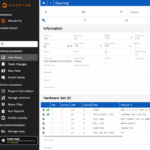This is a shorter version of my article Barricade Device? Think Twice! that can be used in newsletters if the original article is too long. Please leave a comment below if you submit either article for publication, including the name of the publication and the approximate date. Let’s get the word out!
Keys to Classroom Security
Lori Greene, Manager – Codes & Resources, Allegion
With the frequency of school-related threats and incidents on the rise, school security is on the minds of many. While securing exterior doors can help to prevent an intruder from entering a school, classroom doors are an important second line of defense as the threat often comes from within. According to an FBI study of school shootings between 2000 and 2013, “In a majority of high school and middle school incidents, the shooter was a student at the school; this was the case in 12 of 14 high school shootings and 5 of 6 middle school shootings.” During an active shooter incident or other lockdown situation, students and teachers may need to shelter-in-place behind a locked classroom door, or evacuate to a safe location if necessary. It’s important to plan for both possibilities.
The Final Report of the Sandy Hook Advisory Commission includes several recommendations regarding classroom doors, including Recommendation #1 – classroom doors should be lockable from inside the classroom. Another recommendation of this report addresses the distribution of keys to all staff including substitute teachers. The report states: “The testimony and other evidence presented to the Commission reveals that there has never been an event in which an active shooter breached a locked classroom door.” Traditional locksets provide the required level of security for classroom doors, but it is important to consider the location, type, and size of glazing adjacent to the hardware to ensure that the lockset cannot be defeated by breaking the glass.
In a rush to find a way to secure classroom doors within budgetary restrictions, some school districts have implemented the use of barricade devices to lock classroom doors. These products are installed on a door in addition to the original hardware, preventing access from the outside. Unfortunately, solving one problem may inadvertently create others, as most of these devices prevent access by emergency responders, and do not comply with current model code requirements for free egress, fire protection, or accessibility, or with the classroom security guidelines published by the National Association of State Fire Marshals (NASFM).
Another concern is the potential for a barricade device to be used by an unauthorized person who intends to commit an assault, theft, vandalism, or other crime in the classroom. In contrast to school shootings which are rare, nonfatal victimizations at school have become quite common. The National Center for Education Statistics (NCES) reports: “In 2012, students ages 12–18 were victims of about 1,364,900 nonfatal victimizations at school, including 615,600 thefts and 749,200 violent victimizations, 89,000 of which were serious violent victimizations.” Most barricade devices would prevent or delay intervention by staff or law enforcement, which could affect a school’s liability for the incident.
Some states are attempting to use the legislative process to change the codes, so barricade devices may be used on classroom doors. Arkansas Act 606 was passed in March of 2015, and states: “A person may install and use a temporary door barricade device or security lockdown device for security purposes to protect individuals during active shooter events or other similar situations.” In contrast with building code and fire code requirements, this law is dangerously vague, and includes no prescriptive requirements for when, where, or what type of device may be used. This law was passed despite strong objections voiced by the Arkansas State Fire Marshal.
Code change proposals have been submitted by the Builders Hardware Manufacturers Association (BHMA), which could add school security requirements to the 2018 editions of the International Building Code (IBC) and the International Existing Building Code (IEBC). The IBC proposal would require classroom doors to be lockable from within the classroom, and both proposals would require authorized access from the ingress side, in addition to all of the current model code requirements for free egress, fire protection, and accessibility. Using the model code development process rather than using political pressure to change state laws would result in a more consistent approach, utilizing the expertise and experience of code officials and others who are knowledgeable about all aspects of the issue.
The reasoning behind proposed changes is often based on the misconception that barricading the door is the only way to protect students and teachers in the classroom. There are code-compliant locks readily available from many lock manufacturers which provide the needed security without compromising safety in favor of lower cost. While locks address one aspect of classroom security requirements, there are other factors to consider, such as the door, frame, glass, key distribution, communication, and lockdown procedures.
For more information about school security, including an in-depth article on the use of barricade devices, safe options for classroom locksets, and the law enforcement perspective on this topic, visit idighardware.com/schools.
Download a Word document of this article, or a PDF.
You need to login or register to bookmark/favorite this content.






Good morning,
I have linked your article, along with LaForce’s stance on things, on our company blog, at https://laforceinc.wordpress.com/2015/11/23/classroom-barricade-devices-a-potentially-dangerous-development/.
Thank you for the permission and for the detailed information
Emily Schutte
Public Relations and Events Coordinator
LaForce, Inc.
I think people are sort of skimming over the fact that barricade devices absolutely cannot be opened from the outside–period. So if you start with that statement and the data supporting the high percentage of people who commit these horrific acts are indeed students in the school already, you can logically conclude that barricades are not the right answer.
Hi Mary –
There are some barricade device manufacturers that have come up with a way to unlock the devices from the outside – this usually applies to devices that are installed at the bottom of the door, and the release tool goes under the door. I still have concerns about the reliability of these methods and the fact that emergency responders may not have the correct release tools when they need them.
– Lori